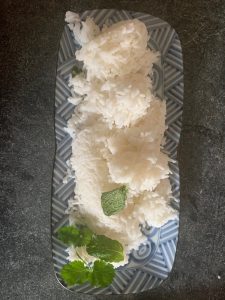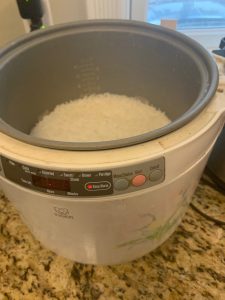This post originally appeared on Murder Is Everywhere.

Scents that jolt our memories are important because we rarely smell them anymore.
Think about that for a moment.
I can still summon the soothing aroma of the Nivea lotion I used during my sixteenth summer. And the piquantly fruity smell of Haribo Gummi Bears, my favorite snack at summer camp. If I smell boiled cabbage, I step back into the hallway of my late grandmother’s home in Germany. And it’s only in India that I can inhale a particular mix of diesel, wood and spices.
I am staying home, probably for a month or two, and I wonder whether there will be a scent from these days that will become a permanent reminder in my olfactory brain.
It is hard to identify the everyday smell of your own home, although anyone who visits you probably has noticed it. I can only smell a change in my environment, and these days, that is the smell of freshly cooked jasmine rice.
Before the quarantine, my go-to rice was basmati, a long-grain rice that originates in South Asia. I buy a 20-pound bag imported from India every 9 months or so from Sam’s Club. The rice supply inside my home bag was running low this winter, and I was too busy to replace the bag before I realized I really needed more.
When the virus began to spread in Baltimore, I had no desire to rush to a warehouse store to look for Royal Basmati Rice along with thousands of other panicking people. Instead, I hurried through jammed neighborhood supermarkets and a gourmet grocery stores. It was Friday the 13th, and the stores were out of lots of staples, including basmati, arborio, and long grain rice. All that was left on the shelves were small bags of sushi rice, and jasmine rice. Jasmine is a medium-length grain that is slightly moister than basmati, but still has enough of a presence that it plays well with Indian curries, and many other dishes.

Jasmine rice is grown in Thailand, Cambodia and Viet Nam, and probably would not be as delicious if people tried to grow it elsewhere. I love this rice varietal’s sizable grain that, when it’s steaming, fills the air with a sweet, almost jubilant aroma. Some say it smells like a combination of a fruit called pandan… and popcorn. Interestingly, jasmine rice doesn’t have a biological relation to the Asian flower, although the jasmine flower’s tiny white blossoms are used often for religious ceremonies also has a powerful smell.
In The Sleeping Dictionary, I wrote about the rice troubles of 1943, when the rice farmed in rural Bengal was shipped out to the troops in such great quantities, that there was not enough left for Indians. About 3 million Indians, mostly Bengalis, died of starvation in the Rice Famine. The wealthy in India hoarded rice in 1943 just as people are hoarding hand sanitizer and toilet paper today. And when the poor flooded Calcutta, begging for food, aid workers had to feed them rice cooking water, because rice itself was too much for their abused stomachs to manage.
Rice is once again a war-time food; a very thrifty, filling and versatile way to keep feeding a family that cannot go shopping. Potatoes go green, bread gets hard and sometimes moldy, but rice perseveres.
People are sometimes afraid to cook rice, but it’s truly very easy.
I’ve cooked jasmine rice straight out of the bag, throwing it unranked in the rice cooker with the prescribed amount of water. You get the best result if you rinse it really well, though, with a few changes of water, before starting to cook the drained, slightly softened rice with a quarter teaspoon of salt, or to taste.

If you don’t have a rice cooker or InstantPot, it’s a cinch (and faster) to add one cup of rice to a hot saucepan on the stove with a little oil on the bottom. Stir for a half minute and pour in one and a half cups of water and the aforementioned salt. When it comes to a boil, put a lid on and change the heat to low-medium. Check in ten minutes or so, and if the water is almost gone, turn off the burner and let the steaming finish. Add a half-cup more water if you want your rice really sticky! If you double the amount of dry rice to two cups, use three cups of water.
I think the sticky/starchy characteristic helps jasmine rice hold its own nicely in the refrigerator for up to a half week—when basmati really gets nasty after more than two days.
I am striving not to throw away uneaten food during this quarantine period, but to repurpose it and eat it swiftly, so I am very happy I wound up with a big bag of jasmine rice. I use my refrigerated leftover rice. I also use it with other ingredients in fried rice and biryani. I could do a rice pudding, or a casserole as well. Rice of any sort freezes well and can be reheated from frozen in a hot pan or the microwave.
I have about eight pounds of jasmine rice, having cooked it about four times so far during the isolation period. I hope it holds out for however long I’m here. The memory of Asia wafting from the rice cooker reminds me of so many happy restaurant meals and far-flung travels. Right now, rice promises me that the world will go on.
